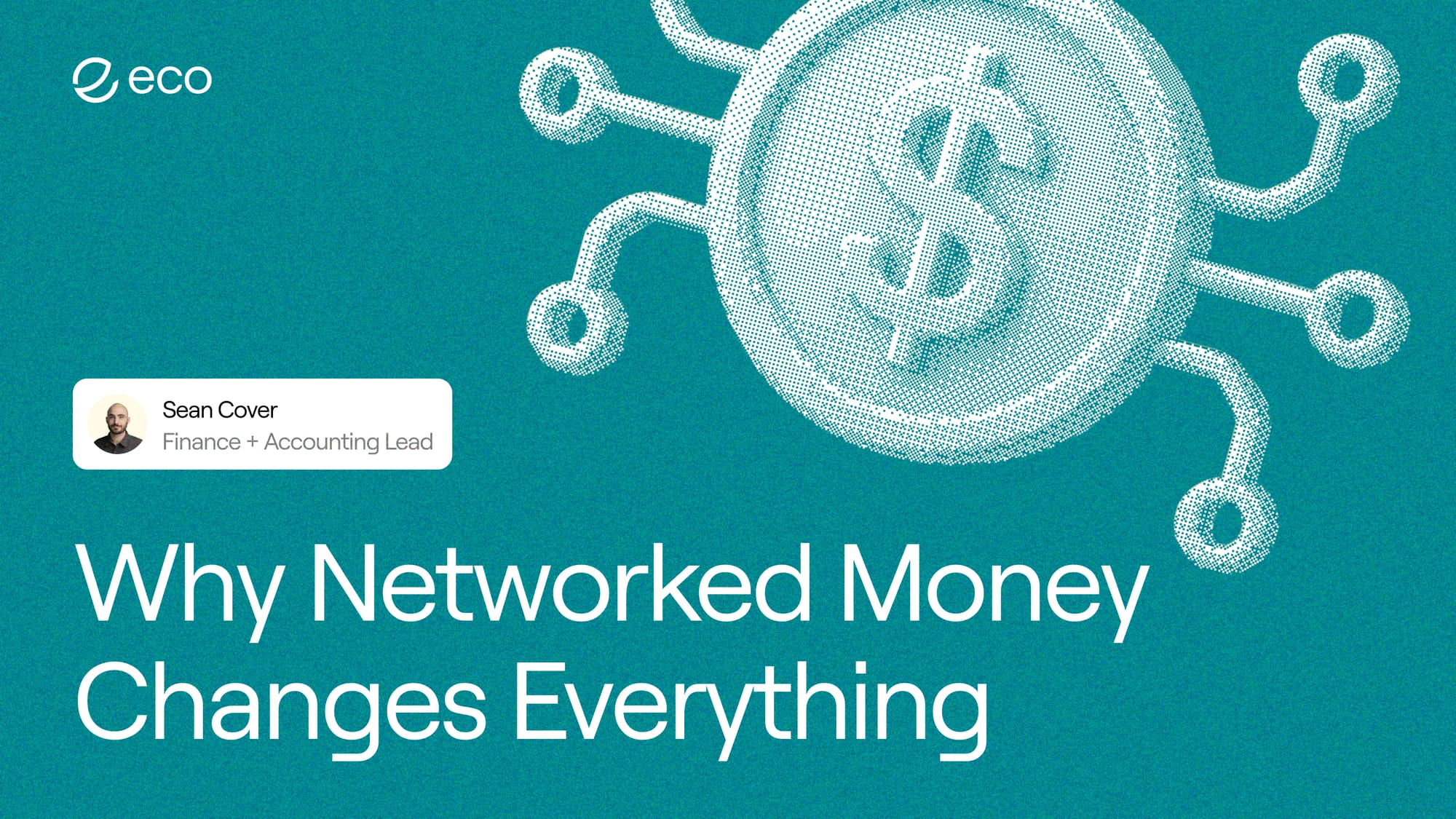Why Networked Money Changes Everything
How the networked nature of stablecoins removes friction and unlocks more liquidity than ever before.

A decade ago, financial institutions dismissed Bitcoin as a fad. Today, they're racing to integrate blockchain technology and launch their own digital assets. But even now, most still miss the fundamental breakthrough.
The revolution isn't about digitizing money. Banks mastered that in the 1970s. Every dollar in your checking account, every stock in your portfolio, every transaction on your credit card has been digital for decades. If digital money were the innovation, we'd already be living in the future.
The breakthrough is something different: money that exists natively on networks rather than in institutional databases. While your bank balance sits in Chase's servers and your Venmo balance lives in PayPal's systems, networked money inhabits thousands of computers simultaneously. No single entity controls it. No institution can freeze it. No server crash can erase it.
Traditional financial institutions are finally beginning to grasp this: not that money can be digital, but that money can exist as a native property of open networks, fundamentally changing how value moves through the world.
The Evolution from Physical to Digital to Networked Money
Money has evolved through distinct phases–from physical coins to digital ledgers and now, protocol-native networked assets. Today’s digital money merely represents physical money in databases. The dollars in your bank account are entries in your bank’s database. When you pay someone with an app, you ask the app to update its database. Your money still lives in one place - controlled by one entity.
Networked money fundamentally changes this. It doesn't live in a single institution's database. It exists simultaneously on thousands of nodes across a global, decentralized network.
You're not storing files like photos on your phone when you hold Bitcoin or stablecoins in a crypto wallet. You're holding cryptographic keys that let you update a global ledger replicated across tens of thousands of independent nodes. Your money doesn't reside in your wallet. It lives on the network itself, accessible from anywhere, controlled by mathematics rather than corporations.
Owning a cryptocurrency means you have the key to moving coins on the blockchain. You can't remove your Ethereum from the network or move it to the safe in your house. Your money is part of the network in a way that the dollars in your bank account are not.
This changes not just where money lives but also how it operates. New economic physics can be unlocked when digital value can flow across borderless networks.
Enabling Instant, Global Synchronization
Traditional finance is siloed. Each bank has its own ledger, and each payment processor has its own system, and they can’t naturally talk to each other. That's why we have ACH, SWIFT, and dozens of different systems to connect these separate systems, and they're slow and expensive.
Networked money changes this completely by allowing dollars to exist on open, permissionless networks, where any application can interact with them without asking permission from anyone. This enables new financial products that would be impossible to build in traditional systems.
A traditional financial institution would never let an anonymous developer create a new product on top of their systems. However, anyone can build on top of blockchain systems. By harnessing the power of the crowd, networked money creates new markets that change how value flows through a global, borderless economy.
When I send you money through the banking system, the transaction is not instant, although it may sometimes appear that way. Banks take time to update their databases, which eventually settle with other banks. Banking is a complex system of promises and IOUs that can take weeks to finalize fully.
With networked money, every participant sees the same state simultaneously through one global ledger, not thousands of disconnected ones. Instead of being a separate process, settlement is built into the system itself. The distinction between payment networks and settlement networks disappears.
This is why stablecoins like USD Coin (USDC) or Tether (USDT) can instantly settle 24/7, while bank transfers take days and don't work on weekends. It's not because banks can't technically do it; their systems aren't networked similarly. Stablecoins are the perfect demonstration of networked money in action.
Creating Trust Without Gatekeepers
Traditional finance relies on the coordination of intermediaries and gatekeepers. Is this check valid? Ask the bank. Did this wire transfer go through? Ask SWIFT. Can this person access financial services? That depends on where they live, their wealth status, and whether institutions decide to serve them.
Networked money changes this trust model. Instead of relying on third-party institutions, verification becomes an inherent property of the system itself. The network cryptographically verifies transactions without requiring trusted middlemen. Instead of waiting for a bank to complete the transfer, crypto networks reach consensus quickly, and everyone sees the same truth simultaneously.
Money wants to move without friction. However, a combination of artificial barriers and gatekeepers has prevented it from doing so.
Networked money exists outside artificial location, status, and wealth boundaries. It operates under uniform rules for all participants, regardless of who they are or where they live. If you have the internet, you can access the same financial rails used by institutions and wealthy individuals. The gatekeepers who previously decided who gets served and who doesn't are simply removed from the equation.
Financial inclusion occurs when artificial barriers fall. It's the natural order, not an act of charity.
Unlocking Programmable Value
Compared to dollars trapped in traditional financial systems, networked money unlocks practical capabilities and use cases that the old system simply cannot support.
Just as the internet transformed from a place to post blogs to the backbone of global commerce and communication, networked money will become the foundation of a more open, efficient, and accessible financial system.
When money becomes a native internet primitive, it can be programmed with complex logic and exceptional capabilities that execute automatically. Value can be transferred according to network conditions and interact with digital systems without human intervention.
Since money is now inherently part of the network it lives on, we can create value that routes itself optimally, develop contracts that enforce themselves, and have financial agreements that adapt autonomously to changing conditions.
Stablecoins represent a perfect example of networked money by combining the stability of traditional fiat currencies with the programmability and openness of crypto networks. Unlike traditional dollars trapped in siloed banking systems, stablecoins can flow without friction between protocols, platforms, and users without relying on gatekeepers.
The combination of value stability with borderless network-native properties creates a form of money that's familiar in value, with new functions just beginning to unlock.
Making Stablecoins Truly Networked
The promise of stablecoins is clear, but today that potential is splintered across blockchains, bridges, and walled‑garden apps. The Eco Protocol tackles that fragmentation by stitching multiple chains and assets into one seamless network so those “network‑native dollars” can finally flow wherever they add the most value, with a single click.
Eco accomplishes this through a universal network that turns individual assets into a cohesive, programmable system. This network architecture eliminates the technical barriers between different blockchains and asset types.
Capital that flows through Eco no longer has to sit in siloed locations. Instead, it flows dynamically to wherever it creates maximum value. Users can interact with any application across any supported chain without concern for which specific stablecoin they hold, and capital pools automatically route to optimal opportunities according to user demand.
Stablecoins that are a part of the Eco Network don't just move more efficiently; they become fundamentally more intelligent and adapt to changing conditions in ways traditional dollars never could.
Eco turns programmable assets into a programmable network, where dollars can flow to wherever they're needed with just one click, whether to users or applications on any connected blockchain. By abstracting away technical complexity, Eco delivers a simple yet powerful interface to networked money that works for everyone, everywhere, instantly.
About Eco
Eco powers real-time money movement across every major stablecoin and blockchain, ensuring dollars flow seamlessly across today's fragmented multichain landscape. Leading apps and protocols integrate Eco to power stablecoin flows where best-in-class execution is required — upgrading stablecoin UX throughout their ecosystems and unifying them all in a thriving Stablecoin Economy.
Website | Eco Docs | Twitter | LinkedIn | YouTube | Discord
About Eco Inc.
Eco Inc. is a blockchain company building software that maximizes money’s value. The company is a founding contributor to the Eco Protocol and the builder of Bend. We expect better from our money, and we want you to as well. That’s what drives us every day.

